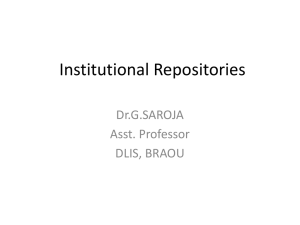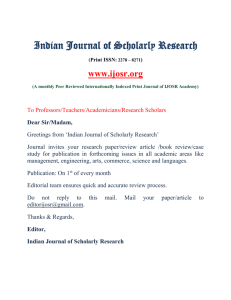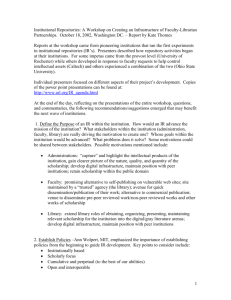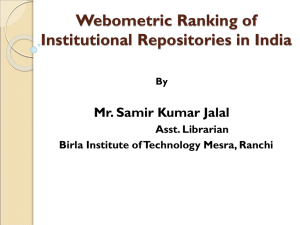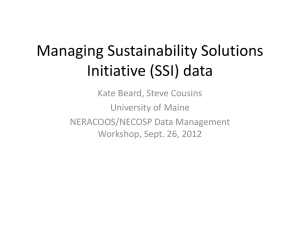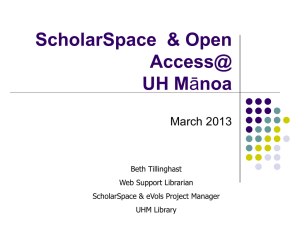Institutional Repository
advertisement
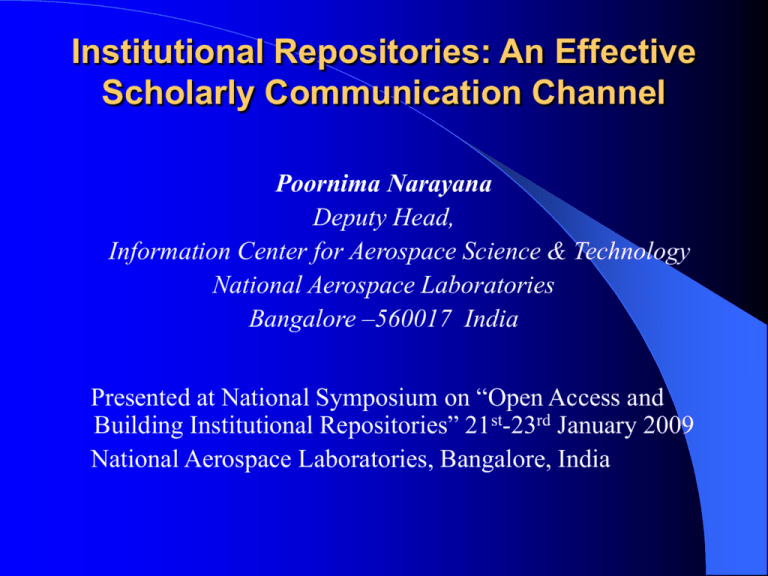
Institutional Repositories: An Effective Scholarly Communication Channel Poornima Narayana Deputy Head, Information Center for Aerospace Science & Technology National Aerospace Laboratories Bangalore –560017 India Presented at National Symposium on “Open Access and Building Institutional Repositories” 21st-23rd January 2009 National Aerospace Laboratories, Bangalore, India Principles and Strategies for the Reform of Scholarly Communication The broadest possible access to published research and other scholarly writings Increased control by scholars and the academy over the system of scholarly publishing Fair and reasonable prices for scholarly information Competitive markets for scholarly communication A diversified publishing industry Open access to scholarship Source: ACRL, 2003 Principles and Strategies for the Reform of Scholarly Communication …… Innovations in publishing that reduce distribution costs, speed delivery, and extend access to scholarly research Quality assurance in publishing through peer review Fair use of copyrighted information for educational and research purposes Extension of public domain information Preservation of scholarly information for long-term future use The right to privacy in the use of scholarly information Source: ACRL, 2003 Publication Channels Journals Technical Reports Conference Proceedings House Magazines Institutional Repositories E-print Archives Institutional Websites ……. What is Open Access User’s aspect Its free availability on the public Internet, permitting any users to read, download, copy, distribute, print, search, or link to the full texts of these articles, crawl them for indexing, pass them as data to software, or use them for any other lawful purpose, without financial, legal, or technical barriers other than those inseparable from gaining access the Internet itself.Initiative, 2002 Source: to Budapest Open Access What is Open Access Author’s aspect The only constraint on reproduction and distribution, and the only role for copyright in this domain, should be given to authors control over the integrity of their work and the right to be properly acknowledged and cited. Source: Budapest Open Access Initiative, 2002 Open access increases impact Nature, vol. 411, No. 6837 (2001) p. 521 Open Access Channels - Refereed free electronic journals, - Research-area-specific archive (e-print) servers, - Institutional repositories of individual universities/institutions and - Self-posting/archiving on authors' home pages. Indian Open Access Journals Sl. No . 1. Publisher Number of Titles Indian Academy of Sciences (IAS) 11 Indian National Science Academy (INSA) 4 Indian Medlars Center of NIC (MedInd) 39 4. Medknow Publications 45 5. Indian journals.com 12 6. Kamala-Raj Enterprises 9 2. 3. Indian OA Journals International Open Access Day on 14 October 2008 National Institute of Science Communication And Information two journals of NISCAIR [ CSIR India ] Indian Journal of Chemistry - Section A and Indian Journal of Biochemistry & Biophysics in Open Access mode . NISCAIR Online Periodicals Repository [NOPR] [ http://nopr.niscair.res.in ]. What is an IR An IR is a service that a Research Organization offers to its community for the management and dissemination of research materials created by the community members Currently used by leading academic and research institutions worldwide for providing improved access to their research publications Institutional Repositories Definition: An Institutional repository is an Organization based set of services which the organization offers to the members of its community for the management and dissemination of digital materials created by the institution and its community members. It is most essentially an organizational commitment to the stewardship of these digital materials, including long-term preservation, where appropriate, as well as organization and access or distribution” (Clifford Lynch 2003) “Digital archives of intellectual products created by the faculty, staff and students of an institution or group of institutions accessible to end users both within and outside the institution.” Institutional Repositories Institutionally based Scholarly material in digital formats Cumulative and perpetual Open and interoperable – But not necessarily free! IR Users Senior administration Graduate students Retiring professors University research documents Institutes and Centres Your own organization Why an IR? • Halving the double dip • Providing outlets for monographs and other specialty publications • Ensuring persistent access to information • Better representation of scholarship created within the institution • Stake or further leadership claim in a specific subject area • For consortia, display the depth and breadth of members’ intellectual output Why Institutional Repositories? For the Individual – Provide a central archive of their work – Increase the dissemination and impact of their research – Acts as a full CV For the Institution – Increases visibility and prestige – Acts as an advertisement to funding sources, potential new faculty and students, etc. For Society – Provide access to the world’s research – Ensures long-term preservation of institutes’ academic output Why Establish an IR? Institutional Benefits – Stewardship of scholarly output – Efficiencies through centralization – Showcase – Proactive response to scholarly communication crisis/open access movement Why Establish an IR? Individual Benefits – Wider distribution – Showcase – Safekeeping – Lowers technology barrier – Time – Persistent URLs Type of Research Material in an IR Published Research Material Ex: Journal articles, Book chapters, Conference papers Unpublished Research Material Ex: preprints, working papers, Thesis/dissertations, technical reports, progress/status reports, committee reports presentations, teaching materials, audio/video clips Supporting Research material Ex: Data sheets, models, blue prints An Institutional Repository can provide A complement to existing Scholarly Communication models A complement to other digital collections (dynamic connections between “texts”) Redundancy of scholarship (NELLCO & RePEc) Collocation for a scholar’s work (Researcher Page) Greater access to grey literature Institutional stewardship & preservation (Are data providers or aggregators as committed long-term as an institution’s library?) Core Features Digital content Community-driven & focused Institutionally supported Durable & permanent Accessible content Core Functionality Material submission Metadata application Access control Discovery support Distribution Preservation How does IR work Research material is hosted and managed on an Institutional Repository server, using appropriate IR software Accessible on the organizational LAN (intranet) + Internet/private network Scientists use a web browser to submit (deposit) research material and also search the repository Through OAI inter-operability protocol, a central search service ‘Harvests” metadata from individual IR’s, builds a cross-index and provides single point cross-repository search service IR Technology IR software (Open Source/Commercial) OAI-PMH harvesting protocol/software (Free) Intel/Pentium servers for IR Linux/Red Hat OS, MySQL/PostGress DBMS, Apache/Tomcat web server, Perl/Java (Free) Standards •Metadata Standards –Dublin Core, SCORM •Character Encoding standards –Unicode •Persistent Identifiers –CNRI Handles –DOI (Digital Object Identifiers) •Harvesting Standards –OAI-PMH IR Software Key component of an IR is the repository management software Several software now available under open source license Comply with OAI metadata harvesting protocol Released and publicly available IR Software ARNO (Academic Research in Netherlands Online), Tilburg University http://www.uba.uva.nl/arno CDSware (CERN Document Server software, CERN, Geneva, Switzerland http://cdsware.cern.ch/ I-Tor (Tools & Technologies for open repositories), Netherlands http://www.I-tor.org/en/toon MyCore http://www.mycore.de/engl/index.html IR Software Dspace - MIT and HP, Cambridge, MA, USA - http://www.dspace.org Eprints - University of Southampton, U>K - http://software.eprints.org Fedora digital object repository management system - University of Virginia, USA - http://www.fedora.info/ What an IR aim to do • Capture and describe digital material using a workflow – Provide interface for online submission of research material (intranet) • Provide access to this material over the web (metadata and/or full pub) • Preserve digital material over long period of time • Expose metadata through OAI-PMH protocol – Default: Unqualified Dublin Core – Other metadata standards EPrints and DSpace Widely used IR software Platform – EPrints: Unix/ Linux/ Perl/ Apache/ MySQL/ XML/ HTML/ – DSpace: Unix/ Linux/ Java/ Tomcat or Apache/ XML/ HTML/ Ant/ PostGreSQL Imply software knowledge required for installing, configuring, and maintaining archives developed using these packages. Institutional Repositories Institutional Repositories World Scenario: Country Wise Sl. No. Country OpenDOAR No. % ROAR No. % 1. United States 292 26.11 226 22.96 2. Germany 124 11.09 83 8.43 3. United Kingdom 118 10.55 107 10.87 4. Australia 53 4.74 33 3.35 5. The Netherlands 44 3.93 23 2.23 6. Canada 40 3.57 42 4.26 7. France 37 3.30 39 3.96 8. Sweden 30 2.68 35 3.55 9. Brazil 26 2.32 55 5.58 10. Italy 38 3.39 29 2.94 11. India 29 2.59 28 2.84 12. Belgium 22 1.96 15 1.52 13. Japan 68 6.08 45 4.57 14. Spain 24 2.14 32 3.25 15. Others 229 20.48 192 19.51 16. TOTAL 1118 100.00 984 100.00 IR Statistics Software: Dspace GNU / Eprints Document Type: - 30% - 25% English German French Spanish Thesis – 50% Grey List – 45% Conference Proceedings – 35% Books – 30% Subject Type: Language: • • • • - 85% – 15% – 10% – 6% • • • • Multidiscipline – 55% Medicine – 7% History – 7% Library & Information Sc – 5 % Growth of the OpenDOAR Database- Worldwide Usage of Open Access Repository Software- Worldwide Subjects in OpenDOAR Worldwide IR: Core Issues • Policy Decisions • Organizational Issues • Cultural Issues Policy Decisions • Scope - Multidiscipline / single subject /Entire research output /database for each functional unit • Types of documents - Single database for different types /single one • Software: OSS like DSpace or GNU Eprints or develop own • Research Deposit Types: Thesis, Journal articles, Preprints, Reports, Conference papers, Book Chapter, etc • Resources: Human (IT, Library), Servers, Funding • Stake holders: Library, Each Department, Institute as a whole • Services Management and Organizational Issues • Deposit options - Researcher self deposit and /or assisted deposit • Metadata quality - Ensuring quality and rich metadata is labour intensive • Mandatory metadata fields • Digitization: Born digital / Scanning • File formats: Accept all, Only PDF and/or other, Conversion • Only full text database and/or Bibliographic • Copyright: RoMeO Publishers Copyright policies • Quality assurance: Peer review, Editing • Deposit Agreement and Use Agreement - Depositor’s declaration: Non-exclusive license - Copyright/Patent/Trademarks - Repository’s rights and responsibilities: Distribute, Store, Migrate, Copy Rearrange, Remove - Use Agreement: Copy, Distribute, Display, Share, Author credit Cultural Issues • Advocacy - Sensitive to organizational culture and background - Community size - Strategy: stakeholders, management committees • Copyright - Concern of researchers, Legal department • Positioning - Library/Institute Website Directories of Open Access Repositories OpenDoar (http://www.opendoar.org/) ROAR (http://archives.eprints.org/) The University of Illinois OAI-PMH Data Provider Registry (http://gita.grainger.uiuc.edu/registry/Info.asp) Openarchives.eu (http://www.openarchives.eu/home/home_do.aspx) OpCit: The Open Citation Project (http://opcit.eprints.org/opcitabout.shtml) RoMEO (Rights MEtadata for (http://romeo.eprints.org /publishers.html) Open archiving Key Features and Functionality Registration of institutional users (authors) - For document submission and other privileged use -User authentication - Profile setup Document submission - Authentication - Assign metadata - Upload document - Grant license Approval/moderation - Submission (metadata, format, affiliation etc) - Content approval (peer review) Key features and Functionality Archiving - Date stamping - Unique/persistent identifier assignment - Preservation support - Indexing and storage Dissemination - Search/Browse - OAI registration and compliance (metadata exposure) - Rights management Administration -Administration communities, collections, users,groups - Document formats, metadata - Licenses, submission policies - Preservation COPYRIGHT ISSUES Berlin Declaration Act recognises the view that community standards will continue to be important in the enforcement of proper attribution and responsible use of the published work The ROMEO project at Loughborough investigated publishers’ attitudes to mounting of pre- and post-prints on servers The SHERPA project at Nottingham has taken over and augmented the ROMEO data http://www.sherpa.ac.uk/romeo.php Yellow publishers allow preprints but not postprints; blue ones postprints but not preprints; green ones both; white neither 61% of publishers on the current SHERPA list formally allow some form of self-archiving; 38% out of the 61% are “green” ARCHIVAL ISSUES Budapest Open Access Initiative Two complementary strategies: Self-Archiving: Scholars should be able to deposit their refereed journal articles in open electronic archives which conform to Open Archives Initiative standards Open-Access Journals: Journals will not charge subscriptions or fees for online access. Instead, they should look to other sources to fund peerreview and publication (e.g., publication charges) IRs and Open Access Promote Open Access Archiving ‘Green Road’ IRs are just one possible vehicle for open access – Open access journals – Subject repositories Harvesters Google, Google Scholar, Yahoo – Harvest metadata from OAI-PMH OAJS, E-PRINT Archives & IRs OAI (Open Archives Initiative) Protocol for Metadata Harvesting – Dublin Core – Self-identification Web Citation Index Metadata Harvesters Indexes/harvests metadata from OA Archives & OAJs Interoperable, cross searching over Repositories OAI-PMH Compliant OAIster – Uni Michigan (wwww.oaister.org) ARC - ODU, Virginia ArXIV (Physics, Maths., Comp.Sc) UIUC Registry of Cultural Heritage ; UIUC Data Provider Registry Metadata Harvesters - India Search Digital Libraries (SDL) /DRTC harvesting L&IS s. subject-specific open access archives and repositories. ‘Knowledge Harvester@INSA’, experimental initiative harvests metadata from 3 archives. “SJPI Cross Journal Search Service” initiative from NCSI at IISc 13 Indian open access journals SEED IITD indexes 4 archives NAL OAI compliant IRs of CSIR Labs. through a unified search interface (PKP Harvester) Open J-Gate (www.openj-gate.org), a free service open access journals indexing service Informatics India Private Limited Scholarly Communication Paradigm IADL: How it operates Tech Reports Pre-prints Journal Articles Presentation Thesis, etc Deposit Metadata +Full Pub) Digital Repository Access & Dissemination NAL DRDO ISRO IISc IITs, Etc Local Intranet access Metadata OAI-PMH Service Provider ICAST, NAL Remote Internet access IMPORTANT CASE STUDIES The ARNO project (Academic Research in the Netherlands Online SPARC launched in 1998 by the US Association of Research Libraries TARDiS (Targeting Academic Research for Deposit and Disclosure U K) CDSWARE (CERN) DAEDALUS (Univ at Glasgow U K) DARE (Digital Academic Repositories Netherlands) FAIR (Funded by JISC) LEADERS (Linking EAD to Electronically Retrievable Sources) Important IRs (World over) Australian National University Aalborg University Universitat Stuttgart Lunds Universitet National University of Ireland University of Glasgow California Digital Library MIT Universite de Montreal Universitat Essen Utrecht University CERN University of Bath University of Nottingham Caltech Academy of Sciences, Belarus Scientific Research in India • The third largest scientific and technical manpower in the world • Vision oriented efforts since Independence (1947 +) • Exclusive Government Departments for Science & Technology, Atomic Energy, Space, Electronics, Oceanography, Biotechnology… • Over 300 Research Laboratories belonging to CSIR, ICMR, ICAR, ICSSR, DRDO, ISRO… • Education/Science performed by IISc, IITs, NITs, IIMs…and most of the Medical/ Engineering/Business Schools, Universities and research labs are of international standards Institutional Repositories: Indian Scenario Nearly 50 Institutions Public Domain (Internet): 35 Campus Network/LAN : 15 Leading IRs IISc, ISI, NAL, NCL, NIO, RRI, DU, IITs 1. Eprints@IISc Indian Institute of Science, (IISc) Bangalore. http://eprints.iisc.ernet.in/ 7672 EPrints 2. Dspace@IIMK Indian Institute of Management, Kozhikode (IIMK) http://dspace.iimk.ac.in/ 295 EPrints 3. Dspace@IIA Indian Institute of Astrophysics (IIA) http://prints.iiap.res.in/ 1903 DSpace 4. Dspace@NITR National Institute of Technology, Rourkela (IITR) http://dspace.nitrkl.ac.in/dspace/ 557 DSpace 5. ETD@IISc Indian Institute of Science (IISc) http://etd.ncsi.iisc.ernet.in/ 289 DSpace 6. Dspac@ INFLIBNET INFLIBNET http://dspace.inflibnet.ac.in 504 DSpace 7. Librarian's Digital Library (LDL) Docum. Res. & Training Centre (DRTC) https://drtc.isibang.ac.in/ 249 DSpace Institutional Repositories: Indian Scenario IR Software Dspace – 25 Eprints - 11 Greenstone – 7 Inhouse - 7 NAL IR website NAL IR website IR - Advantages New and innovative channel of scholarly communication Provide wider access and visibility to the research output Preserves of institution’s heritage Reduce the publication delay IR – Advantages (Contd…) Faster communication Increase the citation to the publications Strengthens research especially in the Indian context Effective communication channel A boon for Gray Literature visibility IR-Technical Benefits • Free software, therefore appropriate for lowincome countries • Easy to establish, technical help available • All IRs are interoperable, conforming to OAIMPH international standards • Distributed network, shared costs • Searchable by Google, Yahoo and specialised search programs (eg OAIster, SHERPA searches) • Usage (impact) statistics available • If embargo, immediate deposit gives email options Strategic Benefits Content free to all with access to Internet (Good for readers) Increases impact of articles (raises visibility of developing country science); increases usage, forges partnerships (Good for authors) Maximises return on investments (already being mandated by institutes and funding bodies) (Good for funders) Shows institutional achievement (Good for institutes) Administrative tool (eg RAE) (Good for institutes) Already ~900 established Little change to existing publishing practice – no new models required Constraints of IR Absence of a well defined institutional policy Lack of IR expertise in India Insufficient funds for IT Infrastructure and manpower Apathy of authors towards time consuming and lengthy deposition procedure. Ignorance of users in the absence of appropriate literacy program Constraints of IR (Contd…) Publisher’s rigid attitude towards copyright policy Customization of open source software is a bottle neck Nature of content: Classified/restricted and Unclassified/Open Diversity of content and the language used in the full texts Relying on unproven methods for long term digital preservation. IRs for sustainable development? A light at the end of the tunnel….. Thank you ?
